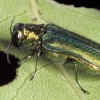Research
Faculty Articles
Tish Carr & Darren Ranco:
- Basketry of the Wabanaki Indians
- Indian Play: Students, Wordplay, and Ideologies of Indianness at a School for Native Americans
Micah Pawling:
- The Sabbatis Tomah Project (from UMaine Today)
- Wabanaki Homeland and Mobility: Concepts of Home in Nineteenth-Century Maine
- Wabanaki Diplomacy
- The Precarious State of a Cultural Keystone Species: Tribal and Biological Assessments of the Role and Future of Black Ash
Sustaining Maine’s Brown Ash Resource


This research project seeks to study and facilitate the ways that Wabanaki basket-makers, tribes, state and federal foresters, university researchers, landowners and others come together to prevent, detect, and respond to the threat of the Emerald Ash Borer (EAB) – a potentially devastating exotic Asian beetle that attacks and kills all three Ash tree species in Maine. EAB has spread from Michigan – where it was first detected in 2002 – east to New York and Quebec, Canada. The economic damage resulting from this invasive species is enormous. For example, the State of Ohio recently estimated EAB-related costs at roughly $3 billion over the next 10 years.
Maine’s Ash Resources and its Use

Maine is home to three Ash species: White Ash (Fraxinus americana), Green Ash (F. pennsylvanica) and Brown or Black Ash (F. nigra). White and Green Ash are most common, and are often found in yards and street plantings. White Ash in particular is valued for its wood for use in lumber, baseball bats, and tool handles. Brown Ash, smaller in stature, is less abundant and often found along streams and other waterways. This species has great cultural significance for the Wabanaki people, and is used to make high-quality basketry.
The Emerald Ash Borer (EAB)

EAB (Agrilus planipennis) is a small exotic beetle from Asia. First found in Detroit in 2002, the beetle is believed to have arrived in the U.S. inside wood shipping pallets. Adult beetles feed on the leaves of all Ash species, causing minor damage. They then lay eggs in the bark of these trees, and the larvae hatch and burrow into the tree. Once there, they feed on inner bark, eventually killing the tree. Since arriving in the U.S., EAB has spread to 13 states and two Canadian Provinces. New infestations typically result from transporting infected firewood.
Responding to the Threat

Like other invasive threats, multiple scales, strategies and ways of comprehending the problem must be considered in responding to the challenge. A key goal of our Project is to help tribal, state, and federal stakeholders become more effective in implementing their management goals for this and other potential impacts to the Ash resource. It is only through such coordinated action that Maine and Wabanaki people will be able to successfully manage and protect this valuable resource for present and future generations.
Research Team & Project Partners

Our team includes university researchers from anthropology, forestry, and ecology, combined with a close working relationship with basket-makers and tribal organizations. Using a range of social science researcher methods, our group is facilitating a process that we believe links knowledge and action for sustainability while at the same time studying how different groups come together to address a common invasive species threat. Our approach pairs social science research methods with explicit knowledge-to-action (K2A) integration. As our K2A work progresses, we will include more stakeholders partners. We believe our work will develop into high integration methods linking social-ecological-systems with a clear K2A.
The Wabanaki Culture

The Wabanaki culture, or “The People of the Dawnland,” include four tribes residing in Maine – the Penobscot, Passamaquoddy, Maliseet and Micmac. The Wabanaki and Brown Ash have coexisted for centuries, long before European exploration in the 1600s. In fact, the Creation Story of the Wabanaki is based on the Brown Ash…
“Glooscap came first of all into this country the land of the Wabanaki, next to sunrise… And in this way he made man; He took his bow and arrows and shot at trees, the basket trees, the Ash. Then Indians came out of the bark of the Ash-Trees.”
— Creation story as told by Molly Sepsis (Passamaquoddy), published in Algonquin Legends by Charles L. Leland, 1884.
How You Can Help…

The most common method of dispersal for EAB is through the transport of infected firewood. Infected wood is very difficult to detect, and viable EAB eggs and larvae can remain inside firewood for more than a year. Please do your part and limit the transport of firewood, and help educate others. In addition, familiarize yourself with the beetle and Maine’s Ash resource, and report any potential EAB sightings to the Maine Forest Service immediately.
